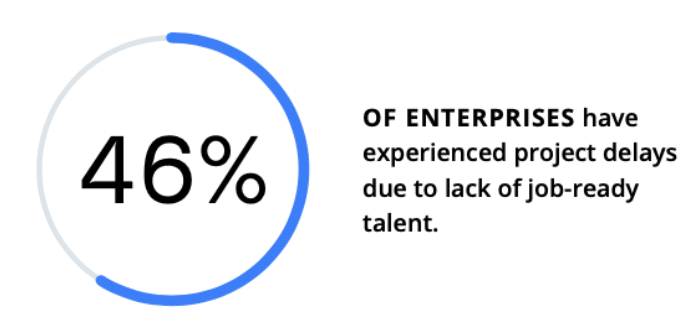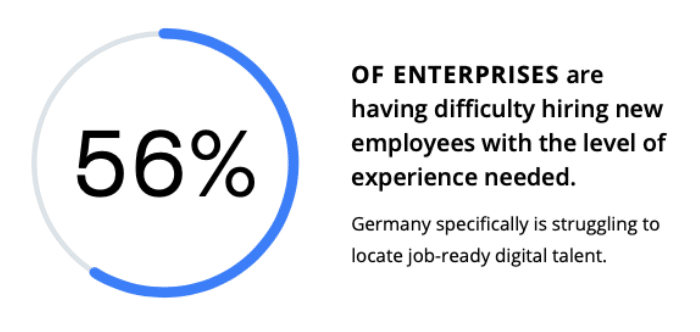From cryptocurrency to the Metaverse, it’s clear that the world overall is becoming more and more digital, and business is no exception. Digital transformation is one of the most important objectives for companies in 2022, especially legacy companies that are lacking in digital means.
Unfortunately, over half of enterprise companies report being held back from full digital transformation by lack of digital talent both in-house and in the pipeline. In order to make meaningful change in this area, it’s important to understand the complexity of the issue. To do this, Udacity partnered with IPSOS to gather and analyze data about talent transformation around the world.
Download the full report for more details.
A Lack of Digital Talent Is Detrimental to Daily Business

Unfortunately, critical innovation and growth within businesses are the first to suffer as talent gaps widen. For companies to stay competitive, they need to keep up with continuously changing technological advances. But if current workers lack digital skills and there’s an inability to hire outsiders with the required knowledge, progress tends to stagnate.
In the Talent Transformation report, 46% of enterprise companies said they experienced delays due to lack of job-ready talent. That includes setbacks like employee turnover, losing skilled workers to high-tech companies, missed project deadlines due to staffing shortages, incomplete projects, and missed digital transformation innovation goals. An enterprise company can typically experience a few of these problems and fair just fine, but it poses a real problem when they’re combined.
Hiring Is Challenging With a Shallow Talent Pool

2022 appears to be a job-seeker’s market. That means anyone with digital skills can choose the best tech companies that are currently hiring. While this is great for the worker, it can leave many enterprise businesses, especially those that haven’t entirely transformed digitally and desperately need skilled digital talent, in a bad spot.
According to the Talent Transformation report, 56% of enterprise companies have trouble hiring new employees with the level of experience they’re looking for in the last six months. This includes difficulties such as finding job seekers with the right experience level or the right technical skills, increased competition in hiring and retaining highly skilled employees, and perpetually unfilled technical roles.
COVID-19 Increased Digital Talent Gaps

The last two years of the COVID-19 pandemic have vastly changed the digital workplace — some for better and some for worse. On the positive side, many companies have transitioned to remote or hybrid working, helping many employees feel happier and more productive.
But on the negative side, COVID-19 forced many businesses to prioritize digital transformation to meet customers online, instead of in traditional retail spaces. This has left many companies behind the times, struggling to survive.
Responses from the Talent Transformation report found that 69% of enterprise companies reported the COVID-19 pandemic disrupted their business. Many tech-forward companies are able to scoop up highly skilled tech talent, leaving little left for the rest of businesses. Plus, with uncertain times, many companies found fewer sales and repeat customers than before 2020..
Don’t Let Digital Transformation Take a Back Seat
While this data may seem troubling for the future of digital transformation at the enterprise level, there’s still hope. Udacity is committed to radical talent transformation to deepen the pool of eligible, job-ready candidates your business needs to thrive in the digital age.
Check out the full Talent Transformation Global Impact Report to get more information on enterprise and employee insights in a digital-first world. Learn more about Udacity’s work to upskill enterprise workforces today.





